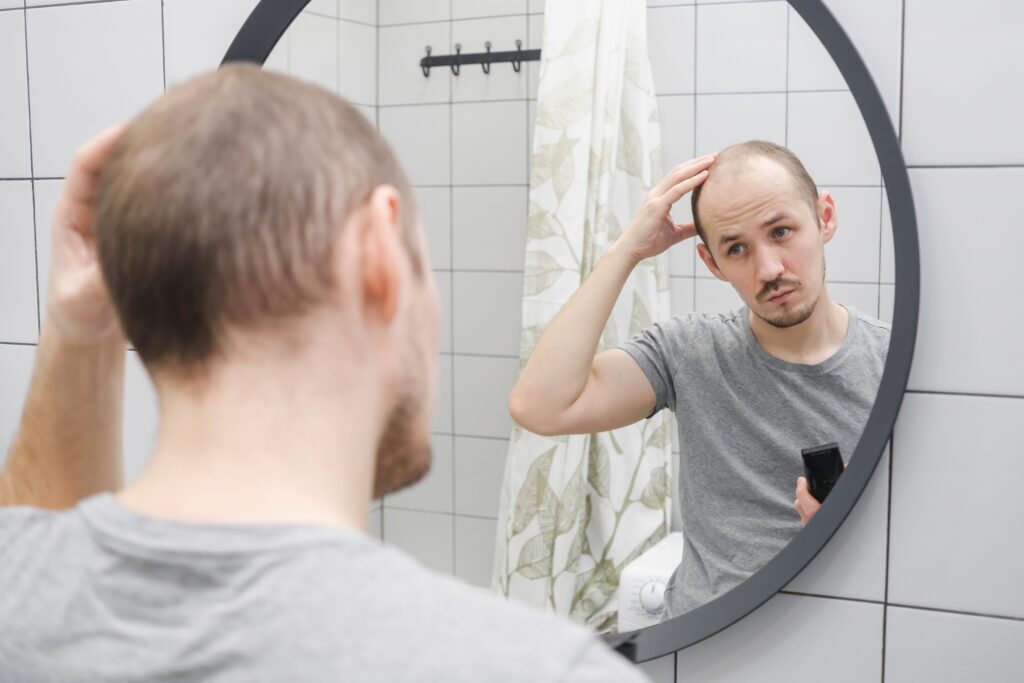Medical Review by Jennie Stanford, MD, FAAFP, DipABOM
Summary:
- Hair loss in men is often influenced by a combination of hormone imbalances, stress, poor diet, and lifestyle choices. Acknowledging and understanding these causes can help manage hair loss.
- A chemical called dihydrotestosterone (DHT) plays a role in male-pattern baldness by shrinking hair follicles and shortening the hair growth cycle, which causes hair to thin.
- Early intervention for hair loss can help reduce the effects. Treatments include FDA-approved medications like minoxidil and finasteride, and surgical options such as Follicular Unit Transplantation (FUT) and Follicular Unit Extraction (FUE).
- Acknowledging your feelings and seeking support can help with the psychological effects of hair loss.
- You should also speak to a healthcare practitioner if you are considering medication or surgical treatment.
Hair loss is a common condition that can deeply affect your self-esteem. A significant number of men experience some degree of hair thinning or baldness during their lifetimes.
Below, we explore the realities of hair loss in men so you can learn more about its causes and potential psychological impact. Then, we’ll show you some of the ways in which you can deal with this natural change.
The good: a natural & treatable process
For many men, hair loss is an inevitable part of the aging process—it affects 30-50% of all men by age 50. So if you’re struggling with male-pattern baldness, the first piece of good news is that you’re not alone.
The second piece of good news is that hair loss in men is treatable to some extent. Different approaches include medication, various therapies, and hair transplant surgeries.
We’ll talk more about the different medications and procedures that can help prevent or manage hair loss in a different section of this article—but before we do, it’s important to understand how hair loss can affect your life.
The bad: the psychological & emotional impact
Although hair loss is natural, it can have a significant impact on your mental well-being. Many men struggle with the psychological and emotional effects of losing hair, which can include these effects:
- A loss of self-esteem
- Feelings of premature aging
- Feelings of diminished masculinity
- Social withdrawal
- Wearing hats and covering the head as a way to hide hair loss
See also: Does Wearing a Hat Too Much Cause Hair Loss?
For these reasons and others, many men seek to stop or reverse hair loss. But before you do this, it’s helpful to know more about what causes hair loss and the best ways to take action.
Common causes of hair loss in men
Understanding the root causes of hair loss is the first step in creating an effective treatment strategy. There are several different common causes of hair loss in men.
Hormone imbalances
This accounts for the majority of hair loss in men and is usually hereditary. It is also known as androgenetic alopecia. Androgens are a type of hormone that can cause your hair to fall out after puberty if your body responds to them excessively.
Autoimmune disorders
Alopecia areata is an autoimmune disorder that attacks hair follicles, eventually causing the hair to fall out completely.
Scalp infections
Ringworm and other scalp infections can lead to hair loss over time.
Stress
When your body experiences enough stress, it can cause a condition called telogen effluvium. This causes many hair follicles to enter their resting phase at the same time, making the hair vulnerable to falling out and thinning.
Poor diet
Iron, protein, B vitamins, and other nutrients play a critical role in supporting hair health. When you don’t eat enough foods that contain them, your hair can become weaker and thinner over time.
Depending on the reason for your hair loss, you may experience your hair thinning or falling out in different patterns. Tools like the Norwood Scale (which we explain below) can help you interpret these patterns to identify the type and severity of your hair loss.
Measuring male hair loss with the Norwood Scale
The Norwood Scale is the most common way to measure the severity of hair loss in men. Your healthcare provider may use this scale to provide a frame of reference if you are losing your hair so that you can seek appropriate next steps or treatments.
The seven stages of hair loss
The Norwood Scale is made up of the following seven steps (also called “the seven stages of hair loss”):
- Stage One: No noticeable loss of hair.
- Stage Two: Hair receding slightly around the temples.
- Stage Three: Deeper recession of hair around both temples, creating an M, U, or V shape.
- Stage Three (Vertex): Alternatively, the hairline may remain at Stage Two while the vertex (or top of the scalp) begins to lose significant amounts of hair.
- Stage Four: More severe recession than in Stage Two, accompanied by total or near-total loss of hair at the vertex. Hair on each side of the scalp is now connected by a band across the top.
- Stage Five: Both areas of hair loss are larger than in Stage Four, and the band connecting them is thinner.
- Stage Six: The areas of hair loss at the temple and vertex connect. The band of hair between them is either sparse or nonexistent at this point.
- Stage Seven: This is the most severe stage of hair loss. At this point, only a narrow band of hair (often thin or fine) remains around the sides of the head.
- Norwood Class A is a different and less common type of hair loss progression where hair recedes uniformly from the front of the scalp to the back of the head.
Understanding DHT & its role
Dihydrotestosterone (DHT) is an androgen that affects how hair growth occurs in men. In men with androgenetic alopecia, DHT plays a central role in hair loss. Here’s how it happens:
- DHT binds to hair follicles in men with certain genetics, especially around the temples and crown.
- When DHT interacts with these hair follicles, it causes a process known as miniaturization.
- During miniaturization, the hair follicles shrink and the anagen phase (growth phase) of the hair cycle becomes shorter.
- As a result, hairs become finer, shorter, and lighter in color. Over time, these affected follicles stop producing hair entirely.
- This process alters the growth cycle of hair, leading to shorter cycles and eventually hair loss.
Preventive measures & early intervention
Early action is one of the most important things you can do to manage hair loss. Here are some tips we recommend:
Maintain scalp health
A healthy scalp environment is vital for hair growth. Regular washing with mild shampoos and treating scalp conditions like dandruff can help avoid forms of stress that lead to hair loss.
Understand your hair loss patterns
Tools like the Norwood Scale allow for the early recognition of hair loss patterns, giving you more time to act before significant hair loss occurs.
Holistic lifestyle adjustments
Stress hormones like cortisol can affect hair follicles, so stress management techniques like yoga or meditation may have a positive impact on hair health and potentially slow the progression of hair loss.
Hair loss medications & procedures
If you are seeking a more decisive way to manage the effects of hair loss, there are a range of treatments that may be able to help:
Hair loss medications
Medications like minoxidil (a topical treatment) and finasteride (an oral medication) are FDA-approved for treating male-pattern baldness. Minoxidil works by widening blood vessels, improving blood flow to the hair follicles, while finasteride inhibits the production of DHT.
Learn more: Finasteride Guide: Uses, Benefits, Side Effects, & More
Surgical treatments for hair loss
If you are looking for a more permanent solution to hair loss, hair transplant surgeries like Follicular Unit Transplantation (FUT) and Follicular Unit Extraction (FUE) are options.
- FUT involves removing a strip of scalp with healthy hair and transplanting it to balding areas.
- FUE, on the other hand, involves extracting individual hair follicles and transplanting them to thinning areas.
These procedures are often sought after when medication is not working effectively or when baldness has reached an advanced stage.
Psychological support & coping strategies
If you find yourself struggling with the mental and emotional effects of hair loss, here are some steps we recommend you follow (based on guidance from the National Alopecia Areata Foundation):
- Acknowledge your feelings: Recognize and accept your emotions about hair loss. It’s normal to feel a sense of loss or frustration.
- Seek support: Talking to others who are going through similar experiences can be incredibly helpful. Support groups or online forums offer a sense of community and shared understanding.
- Find professional help: If hair loss significantly impacts your mental health, consider seeking help from a psychologist or counselor. They can provide strategies to manage stress, improve self-image, and deal with any underlying issues.
- Focus on strengths: Redirect focus from hair loss to personal strengths and talents. This shift in perspective can boost self-esteem and confidence.
- Practice mindfulness and resilience: Practices like meditation, yoga, or mindfulness can foster a more positive outlook and build emotional resilience.
Make an informed plan to tackle hair loss
When you understand what you’re up against and what your options are, finding a way to manage your hair loss becomes significantly easier. Use what you’ve learned above to take decisive next steps—and don’t be afraid to reach out for help if you need it!
Get access to helpful resources so that you have the tools you need to move forward in the direction that works best for you.












